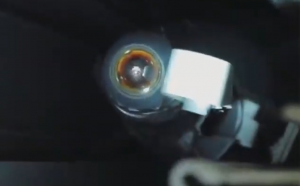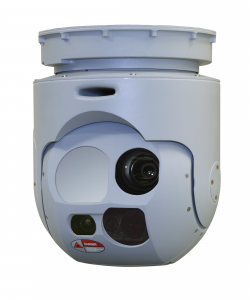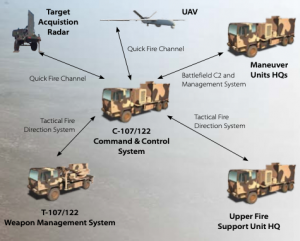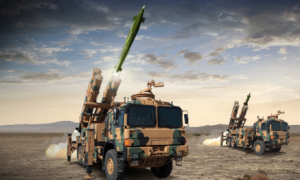By Panos Hadjikomninos
Turkey’s Guided Rocket Artillery
Turkey has long possessed GPS guided missiles made by ROKETSAN, including the TRG-122, TRG-230, TRG-300 [1] families, as well as the BORA (KHAN) Short Range Ballistic Missile (SRBM).
(Note: for simplicity we will use the terms rocket and missile interchangeably)
These advanced high accuracy weapons complement Turkey’s basic unguided rocket arsenal (TR-107, TR-122 and outdated TR-300). Turkey enjoys considerable advantages in funding the development and procurement of domestic weapon systems.
The TRG missiles use GPS guidance (optionally GLONASS) which makes them highly effective against fixed targets, but ineffective against mobile ones.
In a surprising development, ROKETSAN recently announced the first successful trial of a Laser guided 230mm missile. The new system, designated TRLG-230, is basically a TRG-230 equipped with a Laser head (tip).
The TRLG-230 missile adds differentiated terminal guidance to the existing GPS guidance system. GPS guidance is still used for the initial and mid-flight phases. The system’s Control Unit switches over to Laser input during the crucial terminal phase.
When the new missile approaches its target coordinates and a Laser-designator sequence is detected, aerodynamic control will ignore GPS input and switch over to input provided by the Laser head. It will therefore impact the designated target even if it has moved away from its initial GPS coordinates.

Laser Head on a TRLG-230 missile
This separation of initial and terminal guidance makes the new rocket capable of striking mobile targets, adding a significant new capability to the existing 230mm missile family.
Turkey’s Indigenous Drones
Another strong performance of the Turkish defense industry has been the development and evolution of two generations of MALE drones (UAV), in the light (Bayraktar TB2 [7]), medium (ANKA [8]), and heavy (AKSUNGUR [9], AKINCI [10]) categories.
At least one of these, the light Bayraktar TB2, is unique in the international UAV market due to its very small payload and low production cost. The Turkish Army and other services (MIT, Gendarmerie, Navy) bought over 100 of these inexpensive drones. They currently form the majority of UAVs in Turkish Armed Forces (TSK) inventory.
TB2 was designed as a Counterinsurgency (COIN) drone: its light weaponry is sufficient for its mission, striking terrorist groups in the mountains and the odd technical vehicle on a mountain road. In a few cases where heavier armament is necessary, such as the destruction of a cave complex, an F-16 is typically scrambled.
However in Idlib, in a dramatic turn of events, Turkey diverted its drones to a conventional Ground Attack role in order to protect its manned Air Assets from the Russian S-400 AA systems stationed in Khmeimim.
Nobody had diverted Ground Attacks from manned to unmanned Air assets before. It was a Turkish first, facilitated by the massive availability of TB2 drones. The result was an astonishing and somewhat unexpected success.
Thus a new and unique Tactical operational doctrine was born: massively using UAVs for Ground Attack in a (semi) contested airspace, against a conventional state actor.
Despite its unmitigated success, TB2 was immediately assailed by many self proclaimed analysts as inherently “limited” for conventional warfare due to its insufficient payload, both in number of munitions and destructive capacity.
Laser Guidance: two Birds with one Stone
By equipping its long range missiles with Laser guidance, Turkey has managed to kill two birds with one stone:
its rocket artillery now has an extremely accurate weapon against moving targets.
The entire Turkish UAV fleet (both armed and unarmed) is unconstrained from payload limitations: from now on it can use exogenous rockets for precision strikes.
Laser guidance is not in itself a groundbreaking capability: Technically, it is a small incremental step. Advanced countries such as the US have fielded Laser guided artillery shells and missiles for years.
However, Tactically it is a genuine breakthrough for Turkey:
It enhances the advanced precision strike infrastructure that TSK has already in place.
It perfectly complements TSK’s unique Tactical doctrine, that shifts the Ground Attack role from manned to unmanned assets.
Before we can assess the TRLG-230 we must therefore examine how it will be integrated within TSK’s precision strike infrastructure.
TSK Precision Strike Infrastructure for Front Line CAS
During operation Olive Branch, the coordination between ground troops and Turkish Close Air Support assets (mainly F16s) has been exemplary. Even American officers critical of certain Euphrates Shields shortcomings have praised the TSK quality of Close Air Support (CAS) integration during the Afrin campaign.
Trained infantry spotters were embedded in most forward units, typically equipped with advanced, ultra-portable (6kg) Aselsan Viper equipment [3] (Laser designation range: 5/10 km for vehicle/building). They excelled in their role, providing impeccable Front Line CAS throughout the Afrin campaign.

ASELSAN Viper indigenous Laser Designator/Rangefinder system
UAV Precision Strikes Behind the Front Lines
In Idlib a great number of Bayraktar TB2s as well as a limited number of ANKA drones were used for precision strikes behind-the-front, essentially usurping the F-16 Ground Attack mission.
Their intervention was consistent with TSK’s new Tactical operational doctrine of substituting manned assets with UAVs for deep precision strikes behind the front lines. Turkish UAVs, especially the light TB2, were exceptionally successful in their new role.
In a couple of dramatic weeks, TB2 became a conventional warfare star.
Despite being somewhat disadvantaged by its light armament, TB2 managed to achieve near-100% direct hit rate, due to the high effectiveness and maneuverability of ROKETSAN’s MAM L/C [5,6] Laser guided munitions, as well as the extreme quality and versatility of its WESCAM MX-15D [11,12] Laser-designator equipped turret.

WESCAM MX-15 ElectroOptical EO Turret with Laser designation, in the underbelly of a TB2
The success of both Front Line CAS in Afrin, and Behind-the-Front UAV strikes in Idlib, was a high mark for the maturity, professionalism and effectiveness of the TSK.
Enhancing Precision Strikes with Laser Guided Missiles
We have briefly demonstrated two cases of TSK precision strike capability, for Front Line Close Support, handled mostly by F-16s, as well as Behind-the-Lines Ground Attack, assigned mostly to UAVs.
We consider Laser guidance a Tactical breakthrough, because it can be easily integrated within the existing precision strike infrastructure, and confers valuable advantages to both strike missions.
For the Front Line Close Support mission operational practices will remain largely unchanged. The front line embedded spotters (or a forward coordinator) will have a new quick and “light” precision strike option: calling up a Laser missile strike instead of an F-16. Communication of GPS coordinates for initial guidance as well as target Laser designation will essentially remain the same.
However the new Laser guided missiles bring two important advantages.
The first applies when F-16s are unavailable, as in Idlib. Rocket Artillery however will always be available. Highly mobile artillery battery systems (such as the Multi Caliber Launcher MCL [4] see title image) always follow the evolving front line at close but safe distance.
The second advantage is that even when manned fighters are available, you may get a more rapid response from Rocket Artillery: it could take much longer to locate an F-16 with the proper payload.
For the Ground Attack mission, any armed or unarmed drone may call up a Laser missile strike as long as it is equipped with a Laser designator.
MCLs will be positioned within safe distance (typically 10-20 km) from the Front Lines: therefore Rocket Artillery can support Ground Attacks up to 50-60 kms behind the Front with the 70km-range TRLG-230.
UAVs will go through the same Artillery Command & Control communication channel they currently use to call up GPS guided and unguided rocket strikes (see image below).

UAV integration with Rocket Artillery Command & Control: ROKETSAN schematic
The UAV operator provides target GPS coordinates to the Command and Control unit. In addition the UAV will keep its Laser designator on the target until a Laser guided rocket impacts and destroys it.
For the Ground Attack mission, the general advantages of Laser guidance seem familiar: addressing F16 availability, and providing a potentially faster and more adequate solution in terms of payload.
Are there any other, more specific advantages ?
A Formidable Capability Upgrade
The Ground Attack mission is especially important for Turkey, because of the unique TSK Tactical doctrine that mandates extensive use of UAVs in precision strikes behind enemy lines.
We have already seen how Bayraktar TB2s, performed this mission admirably, despite their light armament. The new doctrine’s success notwithstanding, it was immediately assailed by critics, as the Turkish light payload drones were deemed inherently limited for conventional warfare.
With the new Laser guided rockets however, the Turkish Defense Industry has answered the critics by precisely addressing these limitations.
From now on all Laser equipped drones, light or heavy, armed or unarmed, will have limitless precision munition availability, as long as they remain within range of TRLG-230 batteries.
For these light drones, this is equivalent to having unlimited payload for their mission !
And this is only half of the story. The other half is the impact on drone survivability, especially in contested airspace. UAV survivability was another focal point of the Turkish doctrine critics, but it became muted when TB2s managed to destroy more than 13 Pantsir-S1 Anti Aircraft (AA) batteries in Idlib and Libya, while sustaining minimum losses (see History and Success of the Bayraktar TB2 [14]).
When calling up Laser guided missile strikes, TB2 and ANKA drones can destroy their targets from moderate standoff range, away from local AA fire in (semi) contested Air Space.
The superb WESCAM MX-15Di [12] Target Designator of the TB2 has a range of 20Km, clearly beyond the capability of most AA systems. BAYKAR has been totally vindicated for its decision to use a very expensive and capable EO turret on an otherwise inexpensive platform.
The high-end ASELSAN CATS [13] Target Designator in both AKINCI and AKSUNGUR has an even greater range of 30Km. However these drones are also equipped with their own standoff precision weapons — cruise missiles and wing-equipped munitions — with full standoff range (100+ Km).
With virtually unlimited exogenous payload and standoff range, the TRLG-230 system corresponds to a formidable “upgrade” for Turkish drones, especially for the light Bayraktar TB2.
Expanding the Tactical Envelope
We have described two important missions in the Tactical operations envelope of the TRLG-230. The obvious question now is: can we expand this mission envelope ?
It is not a coincidence that the first TRLG-230 demonstration was a strike on a naval target off Turkey’s coast. Laser guided missiles can be used in an anti-ship capacity, especially for the critical — due to Turkey’s vast coastline — coastal defense mission.
Half of the required infrastructure is already in place for this mission: Bayraktar TB2 and ANKA drones are proliferating along the Mediterranean, Aegean and Black Sea coasts in active surveillance of the Turkish sea border and beyond.
The second half is the placement of several highly mobile (typically MCL based) TRLG-230 batteries in constant movement along coastal highways, at intervals of around 100km. We consider mobile batteries clearly preferable to static positions.
Furthermore it may be possible to imitate the Iranians who use canvas covered Mercedes Benz 3340 trucks for their Anti-Ship missiles. These are virtually indistinguishable from freight trucks. I admit this may seem outlandish, but the US (esp. CENTCOM), did not hesitate to transfer useful information to Turkey’s enemies in the past. It may happen again in the future and should be actively avoided: Russia, the US, and certain Western European countries, have sizable fleets of advanced military satellites.
Mobile, constantly moving missile batteries cannot be easily destroyed. Furthermore they can quickly move in a suitable position and prepare to fire in minutes, when threat(s) get identified and their GPS coordinates transferred. Naval vessels, however rapid, will not be able to move more than a few miles in the interim, critically remaining within range.
An additional advantage of highly mobile coastal batteries is the ability to easily transfer them from one coast to another, as new geostrategic threats develop.
Small vessels without AA protection may be destroyed with a single 230mm missile. Larger vessels protected by point defense systems, will be vulnerable to multiple rockets.
Naval point defense systems (such as RAM, Phalanx and their Russian equivalents) are theoretically more effective against ballistic missiles than cruise missiles. However we are convinced that multiple rocket salvos can overwhelm point defense, at less overall cost.
The net result will be the effective creation of a 50+km naval denial zone around the Turkish coast.
A separate mission, different from coastal defense, is the High Seas mission. However, while coastal defenses can rapidly become available, high seas capacity should be a long term goal.
The high seas mission will need a naval version of the missile launcher: it seems that ROKETSAN is already evaluating this option. However this mission will only reach full potential when ships are equipped with their own drones (catapult launched, JATO rocket assisted or vertical takeoff).
Expanding the Rocket Envelope
ROKETSAN manufactures a collection of both GPS guided and unguided missiles.
Guided missiles are denoted by the “TRG” acronym followed by the diameter (in mm) of the missile: currently these are the TRG-122, TRG-230 and TRG-300 families as well as the BORA (KHAN) 610mm conventional SRBMs.
After the TRLG-230 development, remaining families should also get Laser guided versions. In practice TRG-122 may be deemed too small to be in the priority list.
However the TRG-300 “Tiger” missile (see image below) has the perfect size and range for Laser guidance. We are convinced the TRLG-300 version will be next in line.
TRG-300 is offered in two different variants (BLOCK I & II) with ranges of 120km / 90km respectively. Both variants have considerable destructive capacity due to their 105kg / 190kg warheads, plus high kinetic energy on impact.
A modified Laser Head will need to be developed for the 300mm diameter missile and reinforced to withstand higher G-forces and aerodynamic loads. The guidance software will be largely inherited from the TRLG-230.
A TRLG-300 rocket will considerably increase the range and dramatically increase the lethality of TSK precision Rocket Artillery, markedly enhancing effectiveness for all previously discussed missions.

Conclusion
By adding a Laser head to its GPS guided missiles, ROKETSAN achieved a new precision strike capability against mobile targets. For the Front-Line close support mission this is an incremental but important upgrade.
However, for precision strikes behind the Front, a mission which the TSK unique operational doctrine has partially entrusted to its UAV fleet, this development provides a substantial leap in Tactical capability:
Light drones will now have unlimited exogenous rocket “payload” at their disposal, as long as they are within range of a Laser guided missile battery. Moreover they can direct this “payload” to their targets from standoff range.
The capacity impact is massive, especially for the limited-payload Bayraktar TB2 that constitutes the bulk of the Turkish UAV arsenal.
Naval capabilities for the time being will be limited to coastal defense, effectively creating a 50-60 km naval denial zone around 8,000 kms of Turkish coastline.
High Seas naval capabilities may be enhanced by a naval version of the Laser guided missile, but will only come to maturity when ships are able to launch their own Laser equipped drones.
Expansion of Laser rocket availability with a proximate TRLG-300 missile will further enhance lethality and range for all missions. For the important coastal mission it may have a devastating effect.
This development will expand the “denial” zone to 100+ km around coastal and land borders of Turkey, as well as across overseas campaign Fronts.
The new Laser guided precision weapon systems will enhance Turkey’s strategic edge in the Eastern Mediterranean region.
The Turkish defense industry’s ability to improvise, adapt and react to local and changing circumstances, an unmistakable sign of maturity, is no less than astonishing !
References
1. ROKETSAN Product Catalog Roketsan www.roketsan.com.tr, 2019
2. BAYKAR Product Catalog Baykar www.baykardefense.com, 2018
3. ASELSAN VIPER Laser Target Designator Aselan www.aselsan.com.tr
4. MCL Multi-Caliber Launcher Roketsan www.roketsan.com.tr
5. MAM-L Smart Micro Munition Roketsan www.roketsan.com.tr
6. MAM-C Smart Micro Munition Roketsan www.roketsan.com.tr
7. BAYRAKTAR TB2 Baykar www.baykardefense.com
8. ANKA TUSAŞ www.tusas.com
9. AKSUNGUR TUSAŞ www.tusas.com
10. AKINCI Baykar www.baykardefense.com
11. WESCAM MX-15 L3Harris Technologies www.l3harris.com
12. WESCAM MX-15Di L3Harris Technologies www.l3harris.com
13. ASELSAN CATS Aselsan www.aselsan.com.tr
14. BAYKAR: Small Company, Great Ambition-1 (History and Success of the Bayraktar TB2) Straturka www.straturka.com
15. BAYKAR: Small Company, Great Ambition-2 (AKINCI and MiUS Concept) Straturka www.straturka.com






